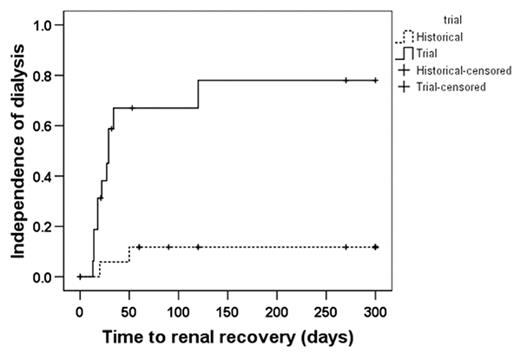Abstract
Irreversible acute renal failure (ARF) is associated with significantly increased morbidity and mortality in multiple myeloma (MM) patients. 10% of MM patients require dialysis support and of these 80% remain dialysis dependent. Cast nephropathy from excess serum free light chains (sFLC) accounts for approximately 70% of dialysis-dependent ARF in this setting. We recently reported preliminary studies demonstrating high cut-off hemodialysis (HCO-HD) as a novel method for FLC removal in MM patients (JASN, March, 2007). The purpose of this subsequent study was to two fold: Firstly, to determine the safety and effectiveness of HCO-HD to result in sustained reductions in sFLC concentrations in cast nephropathy patients. Secondly, to compare renal recovery rates in patients treated with FLC removal HD with a case-matched historical control population.
Methods: 25 patients with dialysis dependent ARF and MM were assessed for inclusion. 3 patients were not suitable for renal biopsy. Renal biopsies demonstrated cast nephropathy in 20 of 22 patients. Only 18 patients commenced treatment as 2 were not suitable for chemotherapy. Thalidomide/dexamethasone regimes were used for patients with de novo MM and bortezomib/doxorubicin/dexamethasone for relapsing patients. FLC removal HD was undertaken using the Gambro HCO 1100™, for extended periods of 8 hours/day. Extended dialysis was supported by replacement of albumin, magnesium and calcium by protocol. Historical age matched control patients received standard high flux dialysis (n=18).
Results: There were no complications related to FLC removal HD. However, 6 of the 18 patients developed infections requiring intervention. The percentage reductions, in sFLC concentrations, achieved by days 5, 12 and 21 were 54 (0–71), 66 (0–88) and 57 (0–88), respectively. There were no significant differences in presenting serum creatinine, sFLC type or concentration between the treatment and control groups. 13 of 18 patients (72%) in the treatment group became independent of dialysis versus 2 of 18 controls (11%, P<0.0001(Figure)). This historical rate of recovery is consistent with the published range of 2–20%. The 13 patients who became independent of dialysis following FLC removal HD achieved a median sustained reduction in sFLC concentrations of 86% (50–93). Their median time to independence of dialysis was 24 days (13–50) with an estimated GFR three months following commencement of treatment of 44mls/min/1.73m2 (29–60). The 5 patients who did not achieve independence had not attained sustained reductions in sFLC concentrations. 4 of these had chemotherapy withheld because of infections, the other had progressive disease not responsive to bortezomib based chemotherapy. Renal recovery was associated with improved Kaplan-Meier survival, P<0.02.
Conclusion: Extended HCO-HD and effective chemotherapy resulted in rapid and sustained reductions in sFLC concentrations with no adverse events. Together, these interventions increased the rate of renal recovery in multiple myeloma patients with cast nephropathy.
Author notes
Disclosure:Ownership Interests: A.R. Bradwell is a major share holder in The Binding Site, who manufacture the immunoassay Freelite™, which was used to measure free light chains in this study.


